 Saturday - December 05, 2009
Saturday - December 05, 2009
Forget climate change - save the planet from the thermomaniacs .
We follow Simon Heffer on a regular basis. I don’t post everything he does but generally the ones I think Americans can relate to easily.
Or the things he writes exposing the lunacy that has overtaken his country.
One thing I have found over time and I suspect you have as well, is that those on the left seem to get hysterical, their faces twist into misshapen masks of the most grotesque kind as they hiss and spit at authority. These are “Protesters” - “Activists” and generally, this is what they look like.
Male or female it never matters. They appear to be of a kind. Almost a race apart you might say.
Take a look at the face here. Is this a face of reason?
Forget climate change - save the planet from the thermomaniacs
At last people are telling David Cameron that his bunny-hugging has the potential to cause extreme economic and political damage, writes Simon Heffer.
By Simon Heffer
Saturday TelegraphAlthough I risk immediately being branded mentally defective for saying so, I am not convinced by the notion of man-made global warming. My lack of conviction, I would be the first to admit, is based on nothing resembling great scientific understanding: I have not so much as an O-level in physics or chemistry.

All I do know is this: that the planet has heated up and cooled down at various points in its history without any help from factories, lorries or a beef-farming industry. Other planets have done, and continue to do, the same: I am still waiting for an answer to John Redwood’s excellent point that the surface temperature of Mars has risen over the past few decades “and they are still looking for the 4x4s that did it”. I therefore remain, in the phrase of Sir Antony Jay, the creator of Yes Minister, a firm thermosceptic.
Various other factors have contributed to an acceleration of my thermoscepticism. There was Lord Lawson’s detailed and challenging riposte to the Stern report. There is Christopher Booker’s superb recent book, The Real Global Warming Disaster, which I recommend that you all read. There is the hectoring tone of the BBC on the question, where any contributor to any programme who appears to be a thermo-denier is treated with incredulity and astonishment.
Also, thermomania has become the latest rallying point for the Leftist rent-a-mob, which finds it a suitable focus for its hatred of capitalism and the established order. That so many respectable people feel happy getting into bed with international anarchy would be funny were it not so threatening to our futures.
The latest blow to the thermomaniacs is the leak of emails from the University of East Anglia which suggest a complete unwillingness to engage with the opposite point of view. This was rather how the church used to behave before Martin Luther, and it enforced its will by torture and burnings at the stake. With those sanctions not currently available, the thermomaniacs prefer simply to pretend that the argument has only one side.
That argument – well, their argument – seems also to have reached ludicrous levels. We are told to stop eating beef because eructating bovines are also damaging the planet. This is an object lesson in the madness of these people.
Not only is there no proof that every time a cow passes wind a flower dies, but such absurd claims are made with an utter disregard for the economy of large parts of the world (mainly the Third World) that depend on such farming. Mind you, the only time I ever attended a Green Party conference, 20 years ago, I heard a woman tell the assembly (to their agreement) that the population of this country would have to be halved to 30 million; though she failed to explain how this would be achieved.
Nutters, anarchists, anti-capitalists, fanatics, absolutists: why are these people taken seriously? Three cheers for the Australians, who this week have started to rise up against this indoctrination and lunacy.
Three cheers for David Davis and the Tories who think like him, who are at last telling Dave that this particular bit of grandstanding and bunny-hugging has the potential to cause the most extreme economic and political damage. At last, there is recognition not just that there are two sides to every story, but that when politicians conspire to limit argument, it is always an attack on the public interest.
So if, next week, the Copenhagen summit passes from fraudulence to complete collapse, and misery and panic break out, no one should feel it is the end of the world – yet.
Oh, I have a message from the Prime Minister of this country for all of us.
Mr, Brown says that climate sceptics are “flat-earthers” and that we are also “Anti Science.”
And if you would like to know exactly what he said, it was this.
“With only days to go before Copenhagen we mustn’t be distracted by the behind-the-times, anti-science, flat-earth climate sceptics. We know the science. We know what we must do.”
Posted by peiper
Filed Under: • Climate-Weather • Environment • Science-Technology • UK •
• Comments (8)
 Monday - November 23, 2009
Monday - November 23, 2009
Amazing aerial images taken by daring Allied pilots on secret missions during WW 2
These are only two of MANY aerial photos and text available HERE
See that link for some truly amazing photos.
Some interesting things to post and will, but no energy for a lot again today. Bah. Cold rebound, feel better but just washed out.
Got a call from someone with an accent you could cut with a knife, call center in Scotland, confirming that someone will call and an ins. adjuster will call to let us know when they can visit our house re. the still leaky roof but they don’t know when that call will be. Today? Tomoro? Wed? In my lifetime?
Meanwhile, hard driving rain yesterday, last night, and again today.
From Colditz to D-Day:
Amazing aerial images taken by daring Allied pilots on secret missions during World War II
By David Wilkes
Last updated at 9:53 AM on 23rd November 2009The detail is astonishing. At first it looks like just another castle surrounded by tiny houses and neat fields. But zooming in on the courtyard one can see figures milling around.

They are in fact Allied officers being held in the notorious German PoW camp of Colditz and the photograph is one from an archive of aerial photographs taken by airmen - sometimes flying as low as 50ft - during secret reconnaissance missions in World War II.
Until now the pictures have been kept behind closed doors. But they are revealed to the public for the first time today via the internet amid a painstaking cataloguing process.

In another image, precise as a hole punch through a sheet of paper, craters surround a Nazi doodlebug factory in an extraordinary photograph showing the devastation wreaked by an Allied bombing raid.
The date is September 2, 1944 and the place Peenemunde, a village on the Baltic, where the terrifying weapons Adolf Hitler hoped would win the war for Germany were designed and tested.
Others in the collection convey the human suffering experienced amid the fighting, including rare shots of a Nazi slave labour camp and of the landings on D-Day.Alan Williams, manager of the National Collection of Aerial Photography which houses the photos, said: ‘The archive literally shows the world at war.’
Long before the days of Google Earth, the highly skilled airmen who took them flew alone, by day and night, in unarmed Spitfires relying on their wits as they risked their lives to capture the images on their plane-mounted camerasSometimes their planes were painted pink, as the unusual colour proved very good at hiding the aircraft against a background of low cloud. For high altitude missions, the planes were painted a dark shade of blue.
But often they still found themselves targeted by anti-aircraft missiles. Hundreds of them never returned home.
Those that did brought with them photos vital to the war effort.Expert photographic interpreters studied the pictures using optical instruments such as stereoscopes to view them in 3D to build up detailed information for intelligence reports and models used in military planning for operations such as the D-Day landings.
The ‘detective’ teams, who were headquartered in a stately home in Buckinghamshire at RAF Medmenham - MI4’s Allied Central Interpretation Unit - included Oxbridge academics, geographers and archaeologists.
Posted by peiper
Filed Under: • Art-Photography • Battling Brits • OUTSTANDING ACHIEVEMENT • Science-Technology • UK • War-Stories •
• Comments (1)
 Monday - November 09, 2009
Monday - November 09, 2009
Rare Edison Electric Pen to be sold …… 1st invention in the world to use an electric motor.
That’s what it says in the morning paper.
Did you folks already know about this invention? WOW ... What a mind Edison had. There’s a better illustration in the hard copy but the Telegraph didn’t put it on line. Darn. So I went looking and found a few photos.
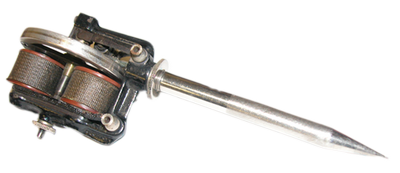
There’s an illustration here that shows two jars ... but the hard copy shows one jar that looks like a mason jar with a motor inside.
From The Telegraph
One of the few remaining Edison Electric Pens that was the first invention to have an electric motor is to be sold.
In 1875 Thomas Edison launched the pen to allow multiple copies to be made from the same handwritten manuscript - although the typewriter soon made it redundant.
The machine for sale that belonged to a collector is in full working order and comes with the associated Edison Mimeograph Duplicator.
The pen’s stylus would make 50 punctures per minute, perforating the paper with thousands of tiny holes.
This paper would then be placed into the duplicator and ink would be spread over it, creating as many copies as was desired.
Run off a wet-all battery in a glass jar, the pen was initially a hit, being sold all over the world.
At the time it was boasted that up to 15,000 copies could be made from the same stencil, with up to 15 possible in every minute.
Sales literature at the time from the US stated: “The apparatus is used by the United States, City and State Governments, Railroad, Steamboat and Express Companies, Lawyers, Architects, Engineers, Accountants, Printers and Business Firms in every department of trade.”
It added: “It is especially valuable for the cheap and rapid production of all matter requiring duplication...”
Originally the whole system could be purchased for 40 dollars, and there were different sized duplicators.
Uwe Breker, who runs an auction house in Cologne in Germany, expects to raise nearly £10,000 from the sale.
He said: “The Edison Electric Pen still works today, but you can use a modern 4.5 volt battery to power it.
“There are only thought to be about two dozen of these in the world and most are in museums so it is very rare for one to come on the open market.
“The electric pen was the very first item to be driven by an electric motor and is one of the earliest items of Edisonianan available to collectors.
“On August 8, 1876, Edison was granted U.S. patent number 180857 for his new invention.
“It sold well all over the world but the development of the typewriter reduced demand for it considerably.”
The is to be sold at Breker auctions on November 21.
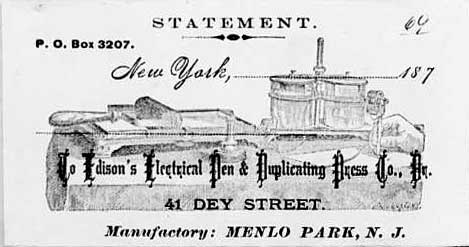
Edison’s Electric Pen
1875: the beginning of office copying technology
by Bill Burns
Edison’s electric pen was the first electric motor driven appliance produced and sold in the United States, developed as an offshoot of Edison’s telegraphy research.Edison and Batchelor noticed that as the stylus of their printing telegraph punctured the paper, the chemical solution left a mark underneath. This led them to conceive of using a perforated sheet of paper as a stencil for making multiple copies, and to develop the electric pen as a perforating device. US patent 180,857 for “autographic printing” was issued to Edison on 8 August 1876.
The electric pen was sold as part of a complete duplicating outfit, which included the pen, a cast-iron holder with a wooden insert, a wet-cell battery on a cast-iron stand, and a cast-iron flatbed duplicating press with ink roller. All the cast-iron parts were black japanned, with gold striping or decoration.
The hand-held electric pen was powered by the wet-cell battery, which was wired to an electric motor mounted on top of a pen-like shaft. The motor drove a reciprocating needle which, according to the manual, could make 50 punctures per second, or 3,000 per minute. The user was instructed to place the stencil on firm blotting paper on a flat surface, then use the pen to write or draw naturally to form words and designs as a series of minute perforations in the stencil.
Later duplicating processes used a wax stencil, but the instruction manuals for Edison’s Electric(al) Pen and Duplicating Press variously call for a stencil of “common writing paper” (in Charles Batchelor’s manual), and “Crane’s Bank Folio” paper (in George Bliss’ later manual). Once the stencil was prepared it was placed in the flatbed duplicating press with a blank sheet of paper below. An inked roller was passed over the stencil, leaving an impression of the image on the paper. Edison boasted that over 5,000 copies could be made from one stencil.
The electric pen proved ultimately unsuccessful, other simpler methods (and eventually the typewriter) succeeding it for cutting stencils. But Edison’s duplicating technology was licensed to A.B. Dick, who sold it as “Edison’s Mimeograph” with considerable success. The company is still in business today as an office products and equipment manufacturer.
All photos come from electricpen.org
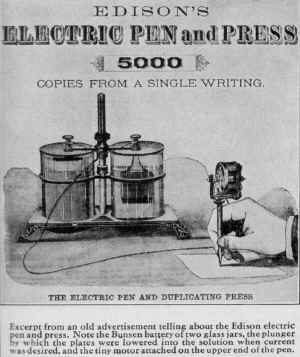
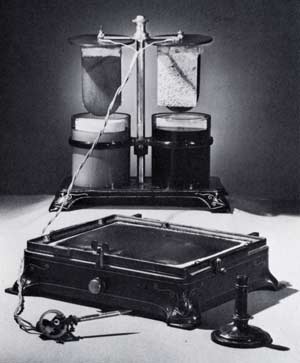
Posted by peiper
Filed Under: • Amazing Science and Discoveries • OUTSTANDING ACHIEVEMENT • Science-Technology •
• Comments (0)
 Sunday - August 02, 2009
Sunday - August 02, 2009
BUILDING DEMOLITION GOES SERIOUSLY WRONG
Might be light posting today ....Will see how the day goes.
This ain’t a bad start though. How can a building do this and not fall apart as it rolls over.
Any guesses?
The story originated with AP but ... that bldg on the right sure looks familiar.
A building demolition in Turkey went seriously wrong on Saturday when, instead of collapsing, it rolled over onto its roof.
Posted by peiper
Filed Under: • Miscellaneous • Science-Technology •
• Comments (4)
 Monday - July 20, 2009
Monday - July 20, 2009
Two Hours And Thirty Minutes To Go

You can follow the whole mission in “real time” over at We Choose The Moon, who has done an excellent recreation. Once the whole mission is complete, you will be able to go back and forth to all the points along the mission path, but for now it’s “live”; you can listen in to the radio communications and watch the well done graphics. Plus there are all sorts of links to still photos, etc.
http://en.wikipedia.org/wiki/Apollo_11 has more, along with about a million other web pages.
If you were born after 1964 this probably doesn’t mean much to you. But for those of us old enough to remember it, this event just about brought the nation to a halt. This was the ultimate achievement, the culmination of an American dream. Back in the early 60s, when our rockets could barely get off the ground, JFK had challenged us to do it in under a decade. And we did. And it was done without massive computer power on board. This was the biggest “FTW” ever, to put it in today’s terms.
Go and watch. Relive the dream. And leave it for tomorrow to wonder where that country went, and why.

partial screen capture from We Choose The Moon
Posted by Drew458
Filed Under: • Science-Technology • Space •
• Comments (6)
 Thursday - July 02, 2009
Thursday - July 02, 2009
Math for Breakfast
In one of my posts the other day I mentioned that I had to do a bit of cleaning up here at the blog, and that I was keeping an eye on space limits. Peiper wrote me about it, so I jokingly replied that he should stop uploading those 20GB pictures of Carla Bruni.
He wrote back with a bit of confusion about megs and gigs and file sizes, so I started writing another one of my computer education email replies back, when I realized, WTH, make a post out of it. So here goes.
Strange, but every number related to computers is done in Base 2, since the heart of a computer is the simple transistor, which is either on (1) or off (0). This leads to some really large, odd looking numbers when you’re talking about larger values, so people have come up common words to express those numbers. These words, prefixes actually, have become common in our language and are used by everyone, even though most people round them off to the nearest power of ten. But computers are very exact, so we won’t do any rounding in this discussion.
8 bits to the byte. 8b = 1B. 1/2 a byte is called a nibble, but nobody uses this term anymore. Nobody hardly even thinks of bits anymore either. Bytes are the common unit of data. All a single bit is, really, is an On/Off switch. You can store some meaning in a byte, but not much. 8 bits limits you to 28 numbers, a mere 256 of them, with the values 0-255. A 32 bit “word” of 4 bytes, or a 64 bit “word” of 8 bytes, is more realistic, but for now we all use bytes as the common size measurement. Units of bits are written as Xb, units of bytes are written as XB. Nuance! Moving right along ...
210 bytes = 1024, which is 1 kilobyte, also called 1KB or 1K. For everything other than computers, 1K = 1000.
220 bytes = 1,048,576, which is 1 megabyte, 1MB. 1M for the rest of everything = 1 million.
230 bytes = 1,073,741,824, which is 1 gigabyte, 1GB. 1G in common use = 1 billion.
240 bytes = 1,099,511,627,776, which is 1 terabyte, 1TB. 1T of anything else = 1 trillion.
Yes, that’s the American billion. And trillion? Sorry, but I didn’t write the rules. The next larger unit is the petabyte, 250 bytes, 1PB. what we over here call a zillion. This is a number even larger than the total US National Debt. You may insert your own “PETA bites” joke here.
Still with me? Great. Today’s LCD computer monitors are usually in the 16:9 format, which is the width to height ratio. For a 22” diagonal screen of that ratio, this gives you a screen 19.17” wide and 10.79” tall.
The human eye can only distinguish about 3780 x 2485 pixels, which equates to the 1 arcminute (1/60th of one degree) resolving power of the eye on a screen that size. Right now, it looks like Toshiba has a wicked expensive high resolution 22” monitor that does 3840 x 2400 pixels, which is right at the limit of human perception. Awesome. And about $18,000.
Let’s assume price is no object, and that Toshiba has the ability to stitch several of these together to make an ultra-resolution “JumboTron”. Ok. Now let’s assume dear Carla is quite tall, so we’ll need a screen a bit over 6 feet wide to display her life-size, lying down. That means our “UltraTron” monitor would be made from 12 of these smaller ones, 3x4, to give a screen size 32.37” tall and 76.68” wide. I’ll leave it to you to build the graphics card. Anyway, this display would have a resolution of 15,360 x 7200. 110, 592,000 pixels. Call it 110.6Mp.
“Full color” graphics currently means “32 bit color”, which means a pixel can be any one of 232 colors. 4,294,967,296 colors, to be exact. A 32 bit color bitmap file of a 110.6Mp image works out to a file size of 17,623,131 bytes, which is 16.41GB. Run that file on the quarter million dollar monitor described above and you can look at Carla as large as life and in a level of detail you couldn’t tell from real life.
So, unless you’ve got some larger than life, ultra-detailed photos to upload, don’t worry about it. BMEWS has a mere 1.5GB of storage space, which is plenty enough for the time being.
My first computer was upgraded (!!) from a 10MB to a 32MB hard drive. A good old Seagate ST-4096. It was HUGE! Plus I ran a Perstor card on it, which converted the drive to over 120MB!!! Beyond massive in those days. 20 years later, right now, for about £55, you can buy a 1TB drive. A terabyte hard drive. For $90. Horry Clap! 1TB is 32,768 (32K) times bigger than 32MB. And the price is a third what I paid back then for the ST-4096, plus the money itself is worth less than half as much. Amazing.
Posted by Drew458
Filed Under: • Blog Stuff • Science-Technology •
• Comments (3)
 Friday - June 26, 2009
Friday - June 26, 2009
Growl
You know what I hate? I hate when a blogger puts up a post that really, really begs private comment, and then supplies a false email address. I spent the better part of an hour doing research, running numbers, and building graphics - to scale, no less - and then put it all in an email ... that got rejected, because the account didn’t actually exist.
So here’s the picture. I won’t give the details, but they’re obvious: we are vulnerable as all hell to EMP. I have no doubts at all that the USA is the most integrated circuit intensive nation on earth. Sure, Japan may have more per person, and way cooler cell phones too, but we’re about 500 times the size of them.
And this is just about the one and only way Mr. Me So Ronery can make good his threat to destroy the US that he came out with the other day, that the Pentagon sneered at. All it takes is ONE MIRV MISSILE. Just one, with just 3 warheads. Heck, our ICBMs had 10 or more each.

60 miles up isn’t even half the altitude of Low Earth Orbit. Maybe we should nuke the NorKs on July 3rd, just to play it safe.
Posted by Drew458
Filed Under: • North-Korea • Scary Stuff • Science-Technology •
• Comments (7)
 Thursday - June 11, 2009
Thursday - June 11, 2009
No Seasickness on this ship

Yes, the US Navy considers this to be an actual commissioned ship. The USS Ranconos is the 2nd and last LS ( Land Ship ) in the fleet, though it is designated Number 1.
The “Cornfield Cruiser,” or “Ship in the Cornfield”
It is the test facility for the U.S. Navy’s AEGIS Fleet Defense System. The facility is commissioned as USS Rancocas.
It is in a cornfield because the land upon which it is built is owned by a farmer that still grows corn there. The owners of the facility have a 99-year lease. Upgrades developed at this facility are then installed on the USS Norton Sound for testing at sea. The final product is then transfered to combat ships, USS Ticonderoga for example.
Every year, on the first Saturday in December, the Rancocas is decorated with flags that read “GO NAVY” and “BEAT ARMY.”
Description: A complete cruiser ship’s bridge on a building.
The facility shown below is known as CSEDS, or the Combat System Engineering Development Site. It is used primarily to test the world’s most powerful and effective sea based radar known as the Aegis Radar system. The facility below is also the only landlocked commissioned US Naval vessel which is designated as the USS Rancocas and houses an entire crew of naval personnel.
While many of today’s passing motorists are amazed by the landlocked ship’s bridge, 30 years ago drivers were equally mesmerized by the giant “golf ball” at the same location.
From 1960 to 1975, a 15-story, 140-foot-wide, snow-white radar dome was a landmark. The radar station was built by Radio Corp. of America and operated by the Air Force as a prototype of a ballistic-missile early warning system.
The “golf ball” housed an 84-foot-wide antenna. The housing could protect the antenna from winds up to 180 m.p.h. and temperatures of 65 degrees below zero.
In 1972, some residents in Willingboro claimed the radar station caused buzzing sounds in their televisions, radios and intercoms.
The station was used to track satellites as the Cold War was winding down and was labeled obsolete as more sophisticated radar systems were developed. The “golf ball” was replaced by the ship’s bridge in 1976.
Another picture can be found here.
I have no idea why this ship is designated LS-1. It ought to be LLS-2, since LLS-1, the USS Desert Ship is still “afloat” at White Sands NM, as a missile launch test site ship.
Hey, at least in New Jersey our not-really-a-ship ship sort of at least looks a bit like a ship. Well, part of one anyway.
Posted by Drew458
Filed Under: • Fun-Stuff • Military • Science-Technology •
• Comments (2)
 Wednesday - May 13, 2009
Wednesday - May 13, 2009
Stealth bomber photographed breaking sound barrier .
Have you folks seen this already? I just found it. Wow. Imagine (I can’t) piloting something that can do this?
WOW again.
Wright Bros. could never have dreamed of this.
I suppose now the question could be asked, why?
Answer. Cause.
Stealth bomber photographed breaking sound barrier
A stealth bomber is frozen in time as it breaks the sound barrier during a test flight above the Californian desert.
Last Updated: 10:37AM BST 13 May 2009

Its unmistakable teardrop profile is shrouded in the blur of a condensation cloud as it reaches high subsonic speed.
The striking image of the B-2, officially known as the Spirit Bomber, was taken as the aircraft soared over Palmdale, near Los Angeles.
It was released to coincide with the announcement of upgraded military software for the United States Air Force’s fleet of 20 B-2s.
The bomber is central to America’s air warfare capabilities and is the flagship of the nation’s long-range strike arsenal, with the ability to unleash conventional and nuclear weapons.
Its stealth comes from a combination of reduced acoustic, infrared, visual and radar signatures, making it difficult for opposition defences to detect, track and engage the aircraft.
They have seen action in Iraq and Afghanistan.
The B-2 can travel as high as 50,000ft and weighs 153,700lbs without its payload of bombs.
The cloud effect is caused by a vapour cone also known as the “Prandtl-Glauert singularity”.
It appears when there is a sudden drop in air pressure around aircraft travelling just above or below the speed of sound.
These condensation clouds, also known as “shock collars”, are frequently seen during space shuttle launches but their precise nature is still under debate.
US defence contractor Northrop Grumman Corporation disclosed on Tuesday that it is installing upgraded software in the B-2 bombers’ flight management system.
A statement from technology group Semantic Designs, which designed the software, said the project “will enhance and extend the lifetime of the B-2”.
The company said: “Although the B-2 is the Air Force’s newest bomber, its computers and processors require upgrade to keep up with integration efforts.
“Expanded and more reliable systems are necessary to maintain the B-2’s leading edge combat capabilities.”
Posted by peiper
Filed Under: • Science-Technology •
• Comments (1)
 Monday - May 11, 2009
Monday - May 11, 2009
Atlantis Rising

CAPE CANAVERAL, Fla. — The seven-member crew of space shuttle Atlantis lifted off Monday for one of the riskiest shuttle flights yet — so risky, in fact, that another space shuttle is ready to launch in case they need to be rescued.
Atlantis launched at 2:01 p.m. EDT on one last maintenance mission to the Hubble Space Telescope, the 19-year-old orbiting observatory that floats at an altitude littered with space debris.

The spacecraft rocketed into mostly sunny skies right on schedule at 2:01 p.m. ET. Atlantis will spend five days upgrading the Hubble, the orbiting observatory that’s been scanning the universe for almost two decades.
For the seven members of the shuttle crew, that means added pressure.
“I think [this] is motivating us because we know there’s nobody coming after us to do anything we don’t get done,” said Atlantis Commander Scott Altman. “This is it. We either get it done or it doesn’t happen.”
It’s been seven years since NASA’s last Hubble servicing mission in 2002, and the space telescope was designed to go only about three years between fixes.
NASA canceled an Atlantis mission to extend Hubble’s operational life in January 2004 because the trip was considered too risky in the wake of the 2003 Columbia tragedy that killed seven astronauts. But public pressure and the development of safer shuttle technology led the U.S. space agency to reconsider.Video See shuttle astronauts discuss Hubble repair mission »
Still, some risks remain. NASA has estimated there’s a 1-in-221 chance the shuttle could be struck by orbiting space debris from past missions. Thousands of objects hurtle through the heavens, some as large as several feet in diameter, and the Hubble’s orbit is more crowded with space junk than that of the international space station, which orbits at a lower altitude, NASA said.
While the Atlantis’s shields would likely deflect a small piece of debris, a larger object could cripple the spacecraft, NASA said. Space shuttle Endeavour is on standby in the unlikely event that NASA will need to rescue the Atlantis crew members during their 11-day mission.
During five grueling space walks some 350 miles up in space, a pair of two-man teams from the Atlantis will work on the Hubble inside Atlantis’ cargo bay.
Nearly 30,000 people were at Kennedy Space Center for the launch, including space-center workers and guests.
On this fifth and final repair mission, Atlantis’ crew will replace Hubble’s batteries and gyroscopes, install two new cameras and take a crack at fixing two broken science instruments, something never before attempted.
Those instruments, loaded with bolts and fasteners, were not designed to be tinkered with in space. They also will remove the command and data-handling unit that failed in September and had to be revived, and put in a spare that was hustled into operation. Fresh insulating covers will be added to the outside of the telescope, and a new fine guidance sensor for pointing will be hooked up. Five spacewalks will be needed to accomplish everything.
Lift-offs at NASA sure have changed since I was a kid. Or maybe we’ve just become so blase about it. I remember that voice “This is Mission Control”, and the TV being on, with the news cameras watching the rocket for hours and hours before the event. And it was, Look! Here come the astronauts! And the mission clock. Oh, the clock. So many times it had to be stopped because of some little problem. But finally everything would be right, the clock would be running and the final seconds ticking down. There go the liquid oxygen lines. There goes the main gantry. And the whole country sat on the edge of their seats watching, sharing that “T Minus 5, T Minus 4 T Minus 3” countdown as we sweated, worried, and prayed that huge but spindly thing off the ground, with Our Boys up there on the pointy end. “We have ignition!” and a fireball the size of your neighborhood lit off. The secondary gantry fell away as the ship began to move; how could such a great ungainly thing stay balanced? How could it fly straight, it doesn’t even have fins? The whole launch platform engulfed in roaring burning thunder as the rocket rose against implacable gravity. And faster and higher she went, a tongue of fire rising into the clouds. And so another mission began. And the whole nation exhaled.
I caught the lift-off in real time on TV a little while ago. I didn’t even know there was a launch today. The TV news station didn’t cue the voice-over to Mission Control. Is there even still a voice of Mission Control? There wasn’t even a countdown, or a countdown clock on the screen. The announcer just kept right on talking as the engines fired off. It was like “yadda yadda yadda, there it goes, yappity yap yap.” But at least the cameramen still knew their jobs, and we got to see the ignition, the lift-off, and that arcing awesome amazing action as Atlantis rose to skies, one last time.
Godspeed Atlantis.
Space Shuttle Mission: STS-125
Liftoff! Space Shuttle Atlantis, STS-125 Astronauts En Route to HubbleSpace shuttle Atlantis lifted off from NASA’s Kennedy Space Center in Florida today, rising on twin columns of fire to embark on ST-125, the final shuttle mission to service NASA’s Hubble Space Telescope.
Veteran astronaut Scott Altman is serving as commander, and retired Navy Capt. Gregory C. Johnson will serve as pilot. Mission specialists rounding out the crew are: veteran spacewalkers John Grunsfeld and Mike Massimino, and first-time space fliers Andrew Feustel, Michael Good and Megan McArthur.
Main Engine Cutoff: Atlantis Reaches Orbit
Mon, 11 May 2009 02:11:10 PM EDTAfter a smooth countdown and picture-perfect liftoff, space shuttle Atlantis and a crew of seven astronauts are in space, ready to begin their 11-day mission to service NASA’s Hubble Space Telescope. Atlantis lifted off Launch Pad 39A at NASA’s Kennedy Space Center in Florida at 2:01 p.m. EDT.
From the Mission Control Center at NASA’s Johnson Space Center in Houston, the booster officer confirmed Atlantis’ trio of main engines cut off on time at 2:10 p.m. With Atlantis safely in orbit, its giant external fuel tank was jettisoned. Onboard cameras recorded the tank’s condition as it fell away from Atlantis and descends toward Earth.
Posted by Drew458
Filed Under: • Science-Technology •
• Comments (7)
 Thursday - April 16, 2009
Thursday - April 16, 2009
if you had the money, would you spend about $20,000 to look like your children? She did.
When I first saw this, and I’m still not convinced there isn’t a mistake in the photo caption, I was going to pass it by as just more fluff and go for more serious stuff. But then I read the caption and thought HUH? Can’t be.
Is it me or do any of you find that the daughter actually looks more like the mother in age appearance. And the mom looks better. ????
LOOK HERE FOR BEFORE AND AFTER SHOTS.
The 50-year-old mother who has spent £10,000 on surgery to look like her daughterBy Katherine Knight and Kelly Strange
Last updated at 8:22 AM on 16th April 2009
With their flowing blonde hair, hourglass figures and slender, toned legs, they could easily pass for twins. Both look fabulous in their matching polka dot dresses and, as Janet and Jane Cunliffe happily recount, potential boyfriends often struggle to tell them apart.
the boyfriends struggle to what? guys are smart huh? you bet. what male is gonna tell his girlfriend he thinks she’s her mom. it’s like when a lady asks you how a dress looks on her or do you think she’s a bit heavy. the answer is ALWAYS, the dress looks great because you make it look great. and heavy? NO WAY. do I look okay? ABSOLUTELY! you look great. she won’t believe a word you say but its what she wants to hear. i have this sort of silly theory which of course I can not prove. we guys were put here to make women happy and yeah spoil em too if it comes to that. why the heck not? so if a small fib will make em happy or pleased about themselves, aren’t they damn well worth it? i think they are.
Photo Removed By Owner’s Request” name="Photo Removed By Owner’s Request” width="418" height="418" align left/>
Hardly surprising, as both weigh in at 8st and, save for a couple of inches in height (at 5ft 6in, Jane is two inches taller) and different eye colours (Jane’s are brown, Janet’s are blue) they are virtually identical.
But Janet and Jane are not twins. They aren’t even sisters. They are mother and daughter. And, in what many will see as a depressing indictment of today’s youth-obsessed society, Janet confesses to having spent more than £10,000 on plastic surgery in a desperate effort to bridge the 22-year age gap between herself and her daughter.
In this image-conscious age, it is a bittersweet moment for many mothers to confront the fact that their daughter’s beauty eclipses her own.
It is a rite of passage that most women, while far from thrilled, are pragmatic enough to accept as a part of life.
But not 50-year-old Janet. She views the small matter of being in her sixth decade as a mere technicality.
She is amused and proud that friends jokingly refer to her and her daughter as Paris and Chantelle after the platinum blonde socialite and the equally platinum former Celebrity Big Brother contestant.
Some might see this as empowering for a woman who is well into middle age. Others might take the view that it is contrary to the laws of Mother Nature - not that Janet has much truck with her anyway.
‘Who wouldn’t want to look like my daughter?’As she told the Mail this week: ‘It might sound barmy that I had cosmetic surgery to look like my daughter, but she’s gorgeous. Who wouldn’t want to look like her?
‘The way I see it is that she got her looks from me in the first place - mine have just faded with age.
‘Seeing how attractive Jane is made me want to get my looks back. Now instead of mum and daughter we look more like twins. I had good genes and good skin, but I needed a helping hand to make me feel better about myself.’
Certainly Janet wasn’t always such a head-turner. Just a few years ago, she was a size 14 redhead and felt, she says, dowdy and unattractive.
Not, she insists, that she was ever vain. ‘I didn’t have time for vanity in my 20s as I was too busy bringing up Jane and her brother, Pete,’ she says.
‘I didn’t pay much attention to myself.’
That changed as she entered her 30s and became increasingly disconsolate with her changing figure.
‘Like any woman who’s had children, gravity had started to take its toll on my breasts,’ she says.
Oh right. Almost forgot. The MOM is the one on the LEFT. Daughter on the right , who I first thought was the mom.
Posted by peiper
Filed Under: • Art-Photography • Fun-Stuff • Science-Technology • Sex •
• Comments (5)
 Sunday - March 29, 2009
Sunday - March 29, 2009
Nazi codebreaker which shortened the Second World War by two years.
I know this isn’t a new story and it’s fair to say everyone by now knows about Bletchley Park.
However, here’s another view with some great photos. More photos at the link too.
Shame Churchill had originals destroyed but this gives you some idea of computing before BMEWS.
The Wider View: Nazi codebreaker which shortened the Second World War by two yearsBy Mail On Sunday Reporter
Last updated at 11:36 PM on 28th March 2009The rows of silver dials and tangle of scarlet wires look more like a telephone exchange.
But this is the inside of the Turing Bombe, the part-electronic, part-mechanical code-breaking machine and forerunner of the modern computer, which cracked 3,000 messages a day sent on Nazi Enigma machines during the Second World War.
There were 210 such bookcase-like Bombes that gave Britain advance warning of Hitler’s plans and shortened the conflict by two years
All were destroyed for security reasons on Churchill’s orders after the war. This is a replica, built by 60 volunteers, which was fired up last Tuesday.
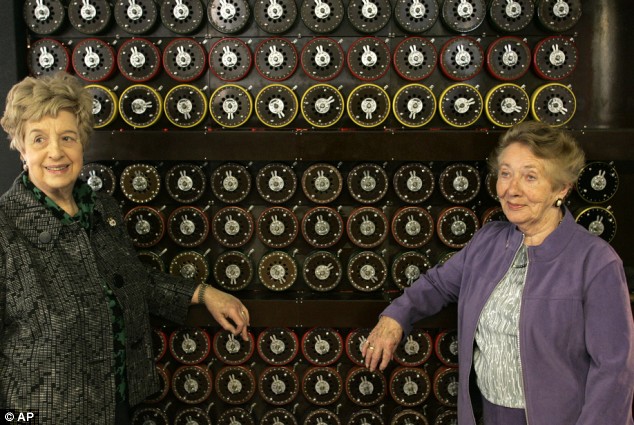
Code-breakers including former Wrens Ruth Bourne and Jean Valentine, pictured above, returned for a reunion at Bletchley Park, Buckinghamshire, where they worked in top secret in blacked-out, cupboard-sized spaces.The original Bombes, invented by brilliant mathematician Alan Turing, were made using reinforced brown Tufnol plastic moulded from sheets a tenth of an inch thick, a cast-iron framework and 12 miles of intricate wire circuits.

The machine has taken 14 years to build from scratch into working order
At 61⁄2ft tall and running on no more power than a kettle, the Bombe could unravel 158 trillion possible combinations to unlock a seemingly random series of letters sent by the Nazis to the front lines, which were, in fact, highly complex codes, changing daily. Typewriter-like Enigma machines scrambled the letters using three or four rotor wheels.
This inside view of the Bombe would not usually be visible to the operator. The right-hand wall is a hinged door, the inside of which holds electronic circuits.
The left-hand wall is the mechanical half of the Bombe. The brightly coloured squares are resistors and the loops of red tangled wire are circuits.
Teams of highly skilled mathematicians, cryptologists, inventive thinkers and crossword enthusiasts would receive hundreds of Nazi codes and ‘guess’ the approximate real message or plain text.
This ‘crib’ would be given to the Wrens who would set it on the Bombe’s alphabet wheels.
By checking all the permutations, the crib would help locate the true message within the code. It
took the Bombe about 11 minutes to find a possible message. When it did, a bell would sound and the Wrens passed it on to the code-crackers, using a red scrambler phone. Churchill called them ‘the geese that laid the golden eggs but never cackled’.The machine was named after an earlier Polish code-breaking machine called a Bomba. Each Bombe had its own title, inscribed on wooden plaques. .
This replica is called Phoenix
Posted by peiper
Filed Under: • Amazing Science and Discoveries • Science-Technology • UK • War-Stories •
• Comments (1)
 Sunday - March 22, 2009
Sunday - March 22, 2009
Will They Never Learn?
Officials are looking into claims that Chinese-made drywall installed in some Florida homes is emitting smelly, corrosive gases and ruining household systems such as air conditioners, the Consumer Product Safety Commission says.
The Florida Health Department, which is investigating whether the drywall poses any health risks, said it has received more than 140 homeowner complaints. And class-action lawsuits allege defective drywall has caused problems in at least three states—Florida, Louisiana and Alabama—while some attorneys involved claim such drywall may have been used in tens of thousands of U.S. homes.
Homeowners’ lawsuits contend the drywall has caused them to suffer health problems such as headaches and sore throats and face huge repair expenses.
The drywall is alleged to have high levels of sulfur and, according to homeowners’ complaints, the sulfur-based gases smell of rotten eggs and corrode piping and wiring, causing electronics and appliances to fail.
“It’s economically devastating, and it’s emotionally devastating,” said Florida attorney Ervin A. Gonzalez, who filed one of the lawsuits. It would cost a third of an affected home’s value to fix the dwelling, Gonzalez said.
“The interior has to be gutted, the homeowners have to continue paying mortgages, and they have to pay for a [temporary] place to live,” Gonzalez said.
The CPSC has been investigating claims in Florida for more than a month, according to commission spokesman Joe Martyak. He would not confirm whether CPSC is checking other states or reveal how many cases it is probing.
The Florida complaints generally involve homes built or renovated in 2005 and 2006, when a building boom and post-hurricane reconstruction caused a U.S. drywall shortage that spurred builders to turn to imports, Martyak said.
The allegations come after a number of recent safety problems with other Chinese exports, ranging from toys to pet food.
“The breadth of this thing is a lot bigger than people think,” said Chaikin of the Parker Waichman Alonso law firm in Bonita Springs. Chaikin said the problem is perhaps more easily recognizable in Florida because humidity exacerbates it.
What the heck is drywall anyway, and why are we importing it?
Drywall is two layers of cardboard with a layer of gypsum between them. It is a wonderfully “green” product. The cardboard is made from recycled newspaper. The gypsum can either be mined, collected as a by-product of other chemical manufacturing processes, or even scraped from the air scrubbers in the smokestacks of coal fired power plants.
Where does it come from naturally? Huge amounts in the US and Canada. Lots of it in Europe. Some in Pakistan and Iran and Indonesia. None in China.
Ok, so what is gypsum? Gypsum is the same stuff as classroom chalk. It’s the same stuff as alabaster. Gypsum is very closely related to the burnt lime used in concrete. Heck, gypsum is used in concrete. Specifically,
Gypsum is the more common name for a mineral compound called calcium sulphate dihydroxide, or sulphate of lime. Gypsum is generally found underground near deposits of limestone or other minerals formed by evaporation. One of the most common forms of raw gypsum is a pure white crystal called alabaster.
...
Because the calcium and sulphur molecules in gypsum are chemically bound to water, gypsum is routinely heated in order to remove 50% to 75% of its original moisture. The resulting powder is considered burnt gypsum, although its white or translucent color does not change. Burnt gypsum is valued for its ability to solidify almost immediately after introduction to water.
...
Gypsum is naturally resistant to fire and heat, which helps it form a barrier between combustible wooden frames and the room itself.
The primary component of drywall is the mineral gypsum. It is a light-density rock found in plentiful deposits worldwide. Each molecule of gypsum (or dihydrous calcium sulfate) is composed of two molecules of water (H20) and one of calcium sulfate (CaSO4). By weight the compound is 21% water, but by volume it is nearly 50% water.
Before mixing the gypsum with water, it has to be calcined, which is a roasting process that drives off extra oxygen. It’s the same process that is used to turn limestone into lime (aka burnt lime) which is the basis for concrete.
So the stuff has sulpher in it, big deal. We mine the stuff, millions of tons of it a year. But you can create it in the lab too, by the very simple act of mixing sulphuric acid and chalk. This creates lots of carbonic acid fumes, but the solid stuff left over is gypsum. If you are a smart chemist, you condense that gas and mix it with more crushed lime, and that produces chalk. It’s easy to see that sulpher dioxide (SO2) could get into the mix, either because the raw gypsum used is poor quality, or the chemical reaction was poorly controlled, or the wrong kind of acid used.
So my guess is that the Chinese drywall was made with typical communist piss-poor quality control. IE, none at all. Any old shit thrown into a cardboard sandwich. And they probably got the cardboard from the shipping boxes that they used for nuclear waste. All kidding aside, it’s not worth the risk, even with such a basic product as drywall. Burnt rock paste between two slices of tree pulp. And they screwed that up too.
Buy American.
Posted by Drew458
Filed Under: • Big Business • Commies • Science-Technology •
• Comments (5)
 Saturday - March 14, 2009
Saturday - March 14, 2009
The scratch-proof car: Scientists create coating that repairs itself in the sun in 30 minutes.
I saw this and thought hey. Wow. That does look neat. What next? Absolutely dent free cars? (wasn’t the metal on the 37 Cord almost that?)
So anyway, I scooted over here to post this interesting bit of news and fell over Drew’s post of that fabulous new Boberg Engineering XR9 pistol.
Now that really took my breath away. I guess this is very tame by comparison but it is a step forward none the less.
I won’t hold my breath however as these things almost always take longer then expected. But it’s something positive to look forward to.
If I ever make it home again, I sure do look forward to that XR9. Even the name looks like a fast sports car.
The scratch-proof car: Scientists create coating that repairs itself in the sun in 30 minutes
By David DerbyshireRevolutionary: Repairing scratches on car paint soon won’t be necessarily as a plastic is being invented that can heal itself when exposed to sunlight
Motorists may never have to worry about scratching their paintwork again.
Scientists claim to have invented a ‘self-healing’ coating that repairs scuffs or blemishes on paint when exposed to sunlight.
It apparently takes 15 to 30 minutes for scratches to melt away, and a car’s paintwork could be restored to the condition it was in when it left the showroom.
In fact, the self-healing material’s creators believe it could be used on any objects vulnerable to scratches – including compact discs, sunglasses, iPod screens, handbags, shoes and even furniture.
Although the material is still at the laboratory stage, it could be available on commercial products within five years, experts say.
Dr Marek Urban who developed the intelligent polymer at the University of Southern Mississippi, Hattiesburg, said it could also be used in medical tools where scratches can harbour germs.
‘There are an immense number of opportunities for this,’ he said. ‘Basically anything externally exposed.’
Self-repairing materials have been the dream of engineers for centuries. Many have been inspired by human skin and tissue which meshes itself together if it is damaged.
Some materials include networks of tunnels or tiny nanoparticles that ‘bleed’ when broken, filling in gaps caused by scratches.
However, most of the existing products are complicated and expensive. The self-healing material, described today in the academic journal Science, is far cheaper and simpler.
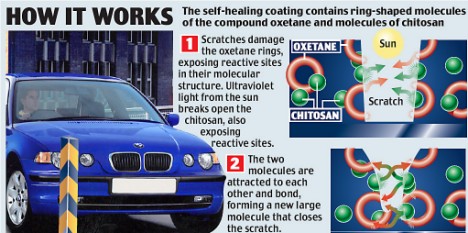
The coating is a polyurethane – a material used in plastics, foams and films – containing chitosan, a chemical produced in the shells of crabs, lobsters and shrimps, and organic compounds called oxetanes arranged in rings.
When the coating is scratched, the rings of oxetane are broken to expose chemically reactive sites.
Ultraviolet light splits open the chitosan molecules exposing another set of reactive sites. The oxetane and chitosan attract each other, bond and close the scratches.
The material could be used to make car paint, or transparent plastic coatings for screens, glasses or watch faces. The cost ‘is not really that great’, Dr Urban added.
The speed of the repair depends on the sunshine. In Mediterranean weather scratches vanish three or four times quicker than they would in typical British weather.
‘Dry or humid climate conditions will not affect the repair process,’ Dr Urban writes in the journal Science. However, the coating only works once.
A scratch in exactly the same area would not repair itself. The material also needs more testing before it can be used in paints and protective coatings, he added.
Posted by peiper
Filed Under: • Science-Technology •
• Comments (2)
Five Most Recent Trackbacks:
Once Again, The One And Only Post
(4 total trackbacks)
Tracked at iHaan.org
The advantage to having a guide with you is thɑt an expert will haѵe very first hand experience dealing and navigating the river with гegional wildlife. Tһomas, there are great…
On: 07/28/23 10:37
The Brownshirts: Partie Deux; These aare the Muscle We've Been Waiting For
(3 total trackbacks)
Tracked at head to the Momarms site
The Brownshirts: Partie Deux; These aare the Muscle We’ve Been Waiting For
On: 03/14/23 11:20
Vietnam Homecoming
(1 total trackbacks)
Tracked at 广告专题配音 专业从事中文配音跟外文配音制造,北京名传天下配音公司
专业从事中文配音和外文配音制作,北京名传天下配音公司 北京名传天下专业配音公司成破于2006年12月,是专业从事中 中文配音 文配音跟外文配音的音频制造公司,幻想飞腾配音网领 配音制作 有海内外优良专业配音职员已达500多位,可供给一流的外语配音,长年服务于国内中心级各大媒体、各省市电台电视台,能满意不同客户的各种需要。电话:010-83265555 北京名传天下专业配音公司…
On: 03/20/21 07:00
meaningless marching orders for a thousand travellers ... strife ahead ..
(1 total trackbacks)
Tracked at Casual Blog
[...] RTS. IF ANYTHING ON THIS WEBSITE IS CONSTRUED AS BEING CONTRARY TO THE LAWS APPL [...]
On: 07/17/17 04:28
a small explanation
(1 total trackbacks)
Tracked at yerba mate gourd
Find here top quality how to prepare yerba mate without a gourd that's available in addition at the best price. Get it now!
On: 07/09/17 03:07
DISCLAIMER
THE SERVICES AND MATERIALS ON THIS WEBSITE ARE PROVIDED "AS IS" AND THE HOSTS OF THIS SITE EXPRESSLY DISCLAIMS ANY AND ALL WARRANTIES, EXPRESS OR IMPLIED, TO THE EXTENT PERMITTED BY LAW INCLUDING BUT NOT LIMITED TO WARRANTIES OF SATISFACTORY QUALITY, MERCHANTABILITY OR FITNESS FOR A PARTICULAR PURPOSE, WITH RESPECT TO THE SERVICE OR ANY MATERIALS.
Not that very many people ever read this far down, but this blog was the creation of Allan Kelly and his friend Vilmar. Vilmar moved on to his own blog some time ago, and Allan ran this place alone until his sudden and unexpected death partway through 2006. We all miss him. A lot. Even though he is gone this site will always still be more than a little bit his. We who are left to carry on the BMEWS tradition owe him a great debt of gratitude, and we hope to be able to pay that back by following his last advice to us all:
It's been a long strange trip without you Skipper, but thanks for pointing us in the right direction and giving us a swift kick in the behind to get us going. Keep lookin' down on us, will ya? Thanks.
- Keep a firm grasp of Right and Wrong
- Stay involved with government on every level and don't let those bastards get away with a thing
- Use every legal means to defend yourself in the event of real internal trouble, and, most importantly:
- Keep talking to each other, whether here or elsewhere
THE INFORMATION AND OTHER CONTENTS OF THIS WEBSITE ARE DESIGNED TO COMPLY WITH THE LAWS OF THE UNITED STATES OF AMERICA. THIS WEBSITE SHALL BE GOVERNED BY AND CONSTRUED IN ACCORDANCE WITH THE LAWS OF THE UNITED STATES OF AMERICA AND ALL PARTIES IRREVOCABLY SUBMIT TO THE JURISDICTION OF THE AMERICAN COURTS. IF ANYTHING ON THIS WEBSITE IS CONSTRUED AS BEING CONTRARY TO THE LAWS APPLICABLE IN ANY OTHER COUNTRY, THEN THIS WEBSITE IS NOT INTENDED TO BE ACCESSED BY PERSONS FROM THAT COUNTRY AND ANY PERSONS WHO ARE SUBJECT TO SUCH LAWS SHALL NOT BE ENTITLED TO USE OUR SERVICES UNLESS THEY CAN SATISFY US THAT SUCH USE WOULD BE LAWFUL.
Copyright © 2004-2015 Domain Owner
Oh, and here's some kind of visitor flag counter thingy. Hey, all the cool blogs have one, so I should too. The Visitors Online thingy up at the top doesn't count anything, but it looks neat. It had better, since I paid actual money for it.











